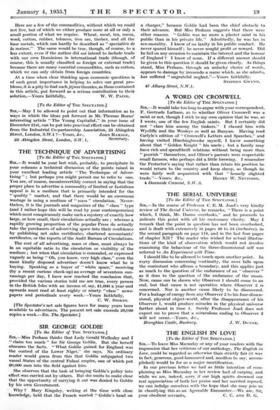THE TECHNIQUE OF ADVERTISING
[To the Editor of THE SPECTATOR.]
would be your last. wish, probably, to precipitate in your columns a technical discussion of the points raised in your excellent leading article " The Technique of Adver- tising " ; but perhaps you might permit me to refer to one. You are, of course, incontrovertibly correct in saying that the proper place to advertise a commodity of limited or fastidious appeal is in a medium that is primarily intended for the " quality " market, and that there would be an enormous wastage in using a medium of " mass " circulation. Never- theless, it is the journals and magazines of the " class " type (and I rather hope this will be read by your contemporaries) which most conspicuously make such a mystery of exactly how large, or how small, their circulations actually are ; whereas a rapidly growing proportion of the popular Press do actually take the purchasers of advert'cing space into their confidence by publishing net sales certificates, chartered accountants' certificates, or the reports of the Audit Bureau of Circulations.
The cost of all advertising, mass or class, must always be in an equitable ratio to the circulation or visibility of the medium ; but when that circulation is concealed, or expressed vaguely as being " Oh, you know, very high class," even the most kindly disposed advertiser doesn't know what he is buying. Speaking as a buyer of white space," receiving (by a recent curious cheek-up) an average of seventeen can- vassings per day, I have now reached the conclusion that, provided the various stories told me are true, every person in the British Isles with an income of, say, £1,000 a year and upwards must read at least eighty or ninety " class " news- papers and periodicals every week.—Yours faithfully, C. W. STOKES.
[The Spectator's net sale figures have for many years been available to advertisers. The present net sale exceeds 20,000 copies a week.—ED. The Spectator.]






































 Previous page
Previous page